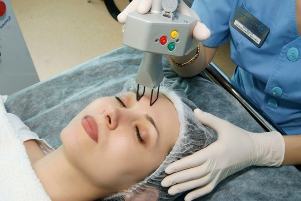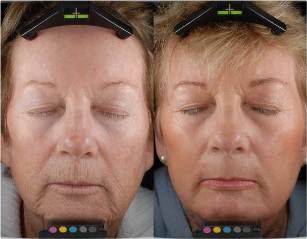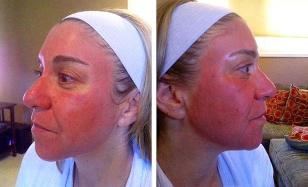
The fractional CO2 laser is an innovative technology in the field of aesthetic medicine and cosmetology that allows you to rejuvenate and soften the skin and get rid of such unsightly imperfections as scars, scars and stretch marks.However, its use is highly controversial. This method of skin care has both supporters, most often among surgeons, and opponents, represented by dermatologists and cosmetologists.
What is this procedure, what effects does it produce, and why does it provoke such conflicting opinions? We will tell you everything in detail and we will answer all your questions.
Fractional laser: description of the procedure and its characteristics
In cosmetology and aesthetic medicine 2 types of fractional lasers are used: erbium, with a lower power level and with shorter wavelengths, and CO2 lasers, which use higher laser power and reach deeper layers of the skin.
Fractional laser treatment produces the following results:
- Rejuvenation.
- Improvement of the structure of the epidermis.
- Reduction of stretch marks, scars and scars.
- Removal of age spots.
- Shrink pores.
- Skin tightening.
- Alignment of the complexion.
- Rejuvenation of the skin by stimulating blood circulation in the capillaries, thanks to which it receives more oxygen, which has a positive effect on its appearance.

The most popular is the fractional CO2 laser resurfacing, which gives excellent results. Due to the increased production of elastin and collagen, the skin regains firmness and elasticity, wrinkles are smoothed and the complexion is even. There is a lifting effect, thanks to which the previous contours of the face return: it becomes clearer and better defined, sagging of the chin and cheeks are eliminated, the nasolabial folds are smoothed.
In the photo you can compare the condition of the patient's skin before and after the fractional laser:
During the procedure, the skin is treated with laser rays that act on 20-25% of its treated area, when a laser head is activated. The laser beams are distributed at certain distances from each other, both vertically and horizontally. The number of rays and the depth of treatment of the skin tissues depend on the setting of the laser parameters in the given area of the skin and the head used. They are selected based on the characteristics of the patient's skin, the treatment area and the type of problem for whose solution the procedure is performed.
The fractional wavelength of the laser is approximately 1550 nm. This results in penetration of the beam to a depth of 2mm into the skin. It stimulates the production of collagen and elastin in the skin tissues, which causes a rejuvenating effect and a reduction of scars and scars. In addition, as a result of the procedure, the regenerative function of the epidermis increases.
To get the desired result, you need to undergo a course of 2-6 procedures, your doctor will tell you the exact number.The duration of the procedure is 40-100 minutes (the processing time depends on many parameters).
Despite the excellent effects, the procedure still causes a lot of negativity, especially among those who were misinformed at first and were disappointed by the discomfort and pain during the procedure.
Functional description of the fractional CO2 laser
Fractional CO2 laser therapy works in a very similar way. The main difference is the wavelength which reaches around 10, 000 nm.This is an ablative technique used to reduce large scars or age spots and for a strong face lift.
The procedure is performed under anesthesia. To do this, an anesthetic cream is applied to the treated area of the skin or pain relievers are taken by mouth.
Despite the pain relief, the patient feels very comfortable treating the skin with lasers. The skin swells, reddens, a feeling of tightness and dryness appears, which is often accompanied by itching. This sensation disappears after approximately 2 days and is replaced by an exfoliation of the epidermis, which may be accompanied by a change in the color of the skin to a darker tone.
Rosacea or redness does not go away completely after about 2 weeks.If the recovery period with the erbium laser treatment lasts 1 to 3 days, the rehabilitation after the fractional CO2 laser treatment will take between 4 and 7 days.But in most cases, the discomfort lasts longer, up to 2 weeks.
It should be noted that to obtain the effect it is necessary to perform 3 to 6 procedures with a frequency of every 3-6 weeks.The results caused by the rearrangement of collagen fibers can be seen only 3-6 months after the procedure. Therefore, CO2 fractional laser skin resurfacing is definitely only suitable for very patient people who are not looking for quick results.
Fractional Erbium Laser
The fractional erbium laser differs from the CO2 laser in lower power and shorter beams: the wavelength is 1064-2940nm. It is safer and gentler on the skin, and also provides a targeted treatment to a specific area and does not affect the surrounding tissues.
It is used in areas of the body with delicate skin: neck, arms, décolleté.

Rehabilitation and care after the procedure
The rehabilitation period lasts 4 to 5 days. Immediately after the procedure, the skin may be red, itchy, scaly, and look unappealing. Therefore, it is advisable to cancel important matters in the next few days after the session and spend them at home, resting. But it should be borne in mind that all the consequences of the procedure completely disappear after about 2 weeks.
Post-procedure skin care plays an important role in the fractional laser outcome.If you want it to look good, you should pay special attention to it in the first days after the procedure. It is necessary to ensure the optimum level of its humidity. After the procedure, your doctor will advise you on moisturizers to use after the procedure.
It is important to remember that in the first days after the session the sun's rays should be avoided, as they can have a destructive effect on new cells and cause discoloration of the skin. Also, you should not take a hot bath, visit a sauna, a pool, swim in open water, purposely sunbathe for the first month.
Another post-treatment guideline is to allow the skin to regenerate at its own pace. It should not specifically increase the peeling of the skin, tear off the scaly areas; this can have a completely opposite effect than expected.
What are the indications and contraindications of the fractional CO2 laser?
The main indications for the procedure are:
- Laxity of the skin.
- Expressed age-related changes.
- Deterioration of facial contours.
- Wrinkles.
- Enlarged pores.
- Scars, stretch marks, acne scars.
- Pigmented spots.
- Decreases the firmness of the skin.
- Benign formations.
These are the contraindications for a fractional laser:
- Pregnancy.
- Cancer.
- Inflammation.
- Skin infections.
- Psoriasis.
- Fresh tan.
- Chronic diseases in acute stage.
- Oncology.
- Diabetes mellitus.
- kelloid predisposition.
- Thrombosis.
Considering all the pros and cons, it should be emphasized that fractional laser treatment should only be performed after consulting a doctor and after having been thoroughly informed about the procedure.You should be fully aware of what to expect during the session and how much you can improve skin imperfections.
It should be assumed that the procedure is uncomfortable and even painful, despite the use of painkillers, moreover, the result appears only after a few months. Therefore, it is not suitable for impatient people with a low pain threshold. Taking into account also the high cost of the procedure (depending on the treated area and the price policy of the cosmetology center), the decision should be made only after carefully considering everything.
Fractional CO2 laser reviews
Most reviews of the fractional laser procedure are positive. Those who did it noted its high efficiency: scars and scars are removed, skin is smoothed, skin relief and texture are improved, pigmentation is reduced and the complexion is evened out. But at the same time, praise is accompanied by complaints. The very high price, the pain of the procedure, the long wait for the results, the severe itching and the redness after the session - these are the moments that cause discontent among patients.
It should be remembered that the effect depends a lot on the professionalism of the specialist who will perform the procedure. So if you decide to get fractional laser resurfacing or skin resurfacing, be very careful when choosing an esthetician. Contacting an inexperienced doctor can lead to a completely opposite effect than expected: instead of improving the skin, it will deteriorate and take a long time to treat.





















